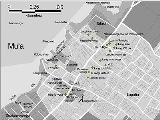
Minthostachys mollis
Encyclopedia
Minthostachys mollis is a medicinal plant restricted to the South American Andes from Venezuela to Bolivia. It is the most variable and widely distributed species of the genus Minthostachys
.
traditions of the Andes
, the plant is made into tea and used medicinally as a carminative
and aphrodisiac
.
are as follows:
Minthostachys
Minthostachys is a genus of the mint family Lamiaceae currently comprising seventeen species of aromatic scandent shrubs. It occurs along the Andes from Northern Venezuela through Colombia, Ecuador, Peru and Bolivia to Central Argentina....
.
Medicinal uses
In the indigenous medicineFolk medicine
-Description:Refers to healing practices and ideas of body physiology and health preservation known to a limited segment of the population in a culture, transmitted informally as general knowledge, and practiced or applied by anyone in the culture having prior experience.All cultures and societies...
traditions of the Andes
Andes
The Andes is the world's longest continental mountain range. It is a continual range of highlands along the western coast of South America. This range is about long, about to wide , and of an average height of about .Along its length, the Andes is split into several ranges, which are separated...
, the plant is made into tea and used medicinally as a carminative
Carminative
A carminative, also known as carminativum , is a herb or preparation that either prevents formation of gas in the gastrointestinal tract or facilitates the expulsion of said gas, thereby combating flatulence...
and aphrodisiac
Aphrodisiac
An aphrodisiac is a substance that increases sexual desire. The name comes from Aphrodite, the Greek goddess of sexuality and love. Throughout history, many foods, drinks, and behaviors have had a reputation for making sex more attainable and/or pleasurable...
.
Chemical characteristics
The principal components of essential oilEssential oil
An essential oil is a concentrated hydrophobic liquid containing volatile aroma compounds from plants. Essential oils are also known as volatile oils, ethereal oils or aetherolea, or simply as the "oil of" the plant from which they were extracted, such as oil of clove...
are as follows:
- pulegonePulegonePulegone is a naturally occurring organic compound obtained from the essential oils of a variety of plants such as Nepeta cataria , Mentha piperita, and pennyroyal. It is classified as a monoterpene....
- menthoneMenthoneMenthone is a naturally occurring organic compound with a molecular formula C10H18O. l-Menthone , shown at right, is the most abundant in nature of the four possible stereoisomers. Menthone is a monoterpene and a ketone...
- mentholMentholMenthol is an organic compound made synthetically or obtained from peppermint or other mint oils. It is a waxy, crystalline substance, clear or white in color, which is solid at room temperature and melts slightly above. The main form of menthol occurring in nature is -menthol, which is assigned...
- (-)-β-pinene
- (-)-α-pinene
- limoneneLimoneneLimonene is a colourless liquid hydrocarbon classified as a cyclic terpene. The more common D isomer possesses a strong smell of oranges. It is used in chemical synthesis as a precursor to carvone and as a renewably-based solvent in cleaning products....
- isomenthone
- piperic acidPiperic acidPiperic acid is a chemical often obtained by the base-hydrolysis of the alkaloid piperine from black pepper, followed by acidification of the corresponding salt...
- eucalyptolEucalyptolEucalyptol is a natural organic compound which is a colorless liquid. It is a cyclic ether and a monoterpenoid.Eucalyptol is also known by a variety of synonyms: 1,8-cineol, 1,8-cineole, limonene oxide, cajeputol, 1,8-epoxy-p-menthane, 1,8-oxido-p-menthane, eucalyptol, eucalyptole,...
- carvoneCarvoneCarvone is a member of a family of chemicals called terpenoids. Carvone is found naturally in many essential oils, but is most abundant in the oils from seeds of caraway and dill.-Stereoisomerism and odor:...
Pharmacological characteristics
| Internal | External |
|---|---|
| Digestive Digestive Digestive may refer to:*Digestion, biological process of metabolism*Digestive biscuit, a British semi-sweet biscuit*Digestif, small beverage at the end of a meal... aid |
Rheumatic pain relief |
| Antispasmodic Antispasmodic An antispasmodic is a drug or a herb that suppresses muscle spasms.-Smooth muscle spasm:One type of antispasmodics is used for smooth muscle contraction, especially in tubular organs of the gastrointestinal tract... (cramp and spasm relief) |
Expelling activity against ectoparasites |
| Antidiarrheal (symptomatic relief for diarrhea) | |
| Anthelmintic Anthelmintic Anthelmintics or antihelminthics are drugs that expel parasitic worms from the body, by either stunning or killing them. They may also be called vermifuges or vermicides .-Pharmaceutical classes:... (expelling parasitic worms) |
|
| Carminative Carminative A carminative, also known as carminativum , is a herb or preparation that either prevents formation of gas in the gastrointestinal tract or facilitates the expulsion of said gas, thereby combating flatulence... (against cramps in the digestive tract) |
|
| Emmenagogue Emmenagogue Emmenagogues are herbs which stimulate blood flow in the pelvic area and uterus; some stimulate menstruation. Women have used plants such as mugwort, parsley and ginger to prevent or terminate early pregnancy... (stimulating blood flow in the pelvic area and uterus, thus sometimes stimulating menstruation) |
|
| Inhalations against catarrh Catarrh Catarrh is a disorder of inflammation of the mucous membranes in one of the airways or cavities of the body. It can result in a thick exudate of mucus and white blood cells caused by the swelling of the mucous membranes in the head in response to an infection... and sinusitis Sinusitis Sinusitis is inflammation of the paranasal sinuses, which may be due to infection, allergy, or autoimmune issues. Most cases are due to a viral infection and resolve over the course of 10 days... |

